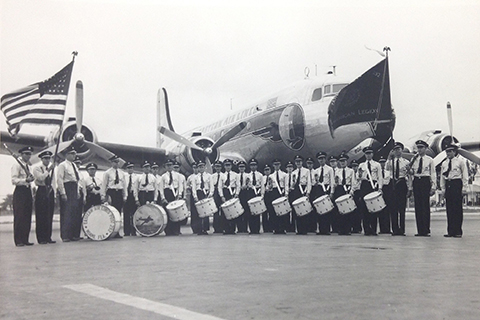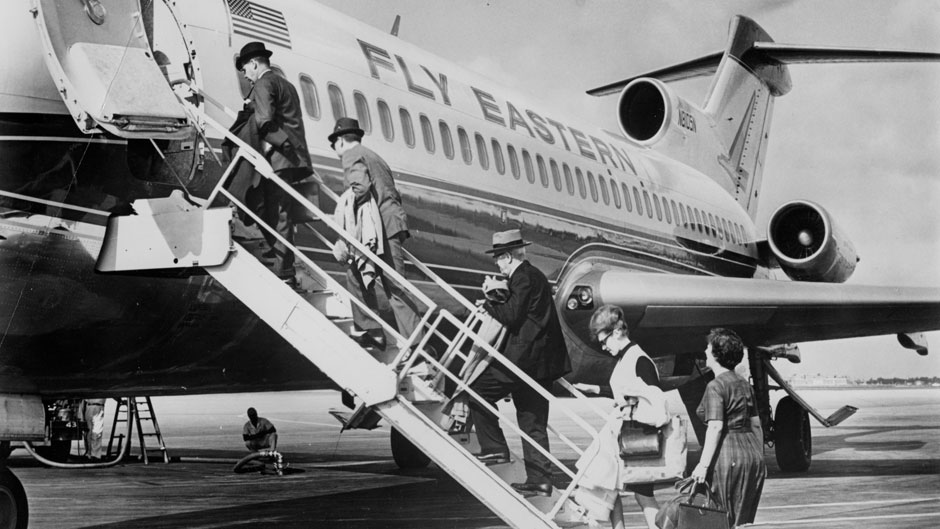On an overcast day, a line of uniformed men are positioned side by side in front of a towering DC-4 aircraft, its four propellers at rest. Flanked by an American flag and a banner identifying the group as American Legion Post 292, the men proudly stand at attention with marching drums slung over their shoulders. The skin of a bass drum placed on the runway nearby is lettered with paint to pinpoint the location: Miami, Florida. The American Legion troop in front of the DC-4 represents the company, Eastern Airlines.
 This black-and-white photographic print, although undated and without a formal description, helps set a tone for how significant the aviation industry was to the development of South Florida. The print is just one of many items in the 440 linear feet of materials in the Eastern Airlines Archive, which was recently donated by the Eastern Airlines Retirees Association to the University of Miami Libraries Special Collections. Now open to researchers and the general public, the complete Eastern Archive – which includes a number of unidentified items, such as the photograph of Legion Post 292 – embodies a nostalgic pride for an airline that still remains in the hearts and minds of its local and global community of former employees.
This black-and-white photographic print, although undated and without a formal description, helps set a tone for how significant the aviation industry was to the development of South Florida. The print is just one of many items in the 440 linear feet of materials in the Eastern Airlines Archive, which was recently donated by the Eastern Airlines Retirees Association to the University of Miami Libraries Special Collections. Now open to researchers and the general public, the complete Eastern Archive – which includes a number of unidentified items, such as the photograph of Legion Post 292 – embodies a nostalgic pride for an airline that still remains in the hearts and minds of its local and global community of former employees.
“These records trace the dramatic growth of Miami as a major tourist destination when Eastern was at one time the largest corporate employer and airline in Florida. Over 12,000 employees resided in Orlando, Tampa, and South Florida,” said Roland Moore, Eastern Airlines’ former director of legal affairs.
Founded in 1926 as a mail carrier, Eastern Airlines was first based in New York City and headed by Edward Vernon Rickenbacker, recognized locally as the namesake for Miami’s Rickenbacker Causeway. A decorated World War I flying ace and pioneer in air transportation, Rickenbacker acquired Eastern’s earliest transportation routes to Florida after World War II. He promoted Florida as a tourist and business destination with easy access to Latin America and the Caribbean, and Eastern soon became the leading airline in the Sunshine State.
In 1975 the airline relocated to Miami under the direction of former NASA astronaut and Apollo 8 commander Frank Borman. With headquarters located at Miami International Airport, the company quickly made Miami the capital of Latin American and Caribbean aviation, boosted business at local airports, created tourism booms in several countries, and eventually distinguished itself as one of America’s most recognized air carriers until it ceased operations in 1991.
“The Eastern donation is a perfect complement to our airline industry holdings, further establishing Special Collections as a premier destination for research into the history of exploration, as well as air and sea navigation,” said Charles Eckman, dean of University of Miami Libraries. “These materials amount to a rich and unique repository, with a deep research value that’s tightly woven into our South Florida culture.”
The Eastern Airlines Archive is comprised of historical materials including correspondence, tens of thousands of photographs and slides, labor files, business records, newsletters, print and video travel advertisements, posters, memorabilia, and artifacts such as flight attendants’ uniforms.
“This collection is a microcosm of the worlds of business, public relations, advertising, fashion, technological advances – all through the fascinating lens of the aviation industry,” said Cristina Favretto, head of Special Collections. “It will appeal to a very wide range of users, from scholars writing very focused books and articles to high school students interested in early aviation history, to people who were connected to Eastern directly and indirectly as employees or passengers. The collection will also appeal to our creative side, because it appeals to the explorer in all of us.”
Eastern joins other signature collections, such as the Pan American World Airways, Inc. Records, World Wings International, Inc. Records, Clipper Pioneers Collection, and the recently donated Jay I. Kislak Collection of the Early Americas, Exploration and Navigation. These collections form the core of a body of resources available to scholars and students who wish to discover more about how airline travel, the travel industry, historical navigation, and the impulse to explore new worlds shaped our present culture. Researchers can touch and examine the original documents, maps, photos, and other materials from these bygone eras, enabling a better understanding of the human industry, enterprise, and creativity that gave rise to these artifacts.
From the early days as a mail carrier in New York City, to growing into an internationally recognized airline that launched South Florida as a capital of aviation, Eastern Airlines continues to hold a special place in history for its legion of devotees – a history that visiting researchers and specialists can support by exploring the collection and potentially helping to identify some of the unknowns within the archive.
“The Eastern community in South Florida is still very close-knit and active, and we were confident that the University of Miami would make the best home for the archive,” said Moore. “We’re thrilled about the possibilities of this collaboration and the new scholarly research to come, but we’re most pleased that the legacy of Eastern will live on.”
A commemorative event is being planned to honor the Eastern Airlines Retirees Association for their important donation to the University and community-at-large. For questions about the Eastern Airlines Archive or to lend your support to its processing and organization, please contact Cristina Favretto at 305-284-3247 or asc.library@miami.edu.

